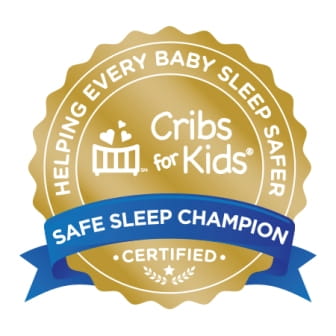Studer Family Children’s Hospital is a certified Safe Sleep Hospital
 Studer Family Children’s Hospital is certified as a Safe Sleep Hospital through the Cribs for Kids National Safe Sleep Hospital Certification Program. We are dedicated to making your baby’s sleep environment as safe as possible.
Studer Family Children’s Hospital is certified as a Safe Sleep Hospital through the Cribs for Kids National Safe Sleep Hospital Certification Program. We are dedicated to making your baby’s sleep environment as safe as possible.
As a certified Safe Sleep Hospital, Studer Family Children’s Hospital follows guidelines set by the American Academy of Pediatrics for safe sleep. We provide education and guidance to parents and caregivers on safe sleep practices. To HELP ensure your baby sleeps safely, follow the ABCs of safe sleep:
Alone—Share your room, not your bed. Your baby should not sleep with others in a bed, on a couch, or in a chair.
Back—Your baby should sleep on his or her back in a safety-approved crib on a firm mattress during naps and at nighttime.
Crib—The crib should be empty. Remove all loose bedding, comforters, quilts, stuffed animals, bumpers, wedges, and pillows from your baby's crib.
More tips for safe infant sleep at home
Care teams at Studer Family Children's Hospital are committed to providing you with information to help your child sleep safely. Here are some recommendations from our pediatricians and pediatric specialists:
- Place your baby on their back to sleep every time – for naps and at night.
- Use a safety-approved crib, bassinet, or portable crib for sleep. Your baby’s sleep area should conform to the Consumer Product Safety Commission (CPSC) safety standards.
- Do not let your baby get too hot during sleep.
- A pacifier not attached to a string at naptime and bedtime is recommended. If you are breastfeeding, wait until breastfeeding has been established to introduce a pacifier.
- Do not allow cigarette smoke around your baby.
- Use a firm, flat, non-inclined surface covered by a fitted sheet.
- There should be no gaps between the mattress and the side of the crib, bassinet, portable crib, or play yard.
- Keep soft objects like pillows, blankets, toys, stuffed animals, and bumpers out of your baby’s sleep area.
- Do not attempt to fix a broken crib – replace it.
- Avoid commercial devices marketed to reduce SIDS, such as wedges, positioners, and special mattresses or sleep surfaces.
- It is recommended that babies sleep in their caregiver’s room, close to the bed, but on a separate surface designed for infants for at least the first six months.
- Your baby should not sleep in an adult bed, on a couch, or a chair alone, with you, or with anyone else.
- Sitting devices, such as car seats, strollers, swings, infant carriers, and infant slings, are not recommended for routine sleep, particularly for infants younger than four months. If your baby falls asleep in a car seat, stroller, or other carrier, move them to a firm sleep surface such as a crib, bassinet, or portable crib for sleep.

